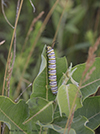Monarch
(Danaus plexippus)
Conservation • Description • Habitat • Ecology • Distribution • Taxonomy
Conservation Status |
|||
| IUCN Red List | LC - Least Concern On 7/21/2022, the IUCN reported that the monarch butterfly would be listed as Threatened. As of 3/3/2024, the list has yet to be updated with this change. |
||
| NatureServe | N5B - Secure Breeding, N2N3N - Imperiled to Vulnerable Nonbreeding S5B - Secure Breeding |
||
| Minnesota | not listed Species in Greatest Conservation Need |
||
Description |
Monarch is a large, widely recognized, migratory butterfly. Adults have a wingspan of 3⅜″ to 4¼″. The male is slightly larger than the female. The upperside of both wings is orange with heavy black veins. The veins of the male are thinner and well defined and, while those of the female are thicker blurred. The subapical area of the forewing has four small, pale orange spots and a small white or pale orange spot. They are arranged as two short lines of spots. The outer margin has a broad, black border with two submarginal rows of white spots. The leading edge (costal) margin has a broad, black border with five white spots near the middle. The inner margin has a broad black border on with no spots. There is no V-shaped indentation on the leading edge of the forewing cell. The upper side of the hindwing has a broad, black border on the outer margin with two rows of white spots. There is no curved, black postmedial line. On males there is a small, black, oval, scent patch on a vein near the center of the hindwing. The underside of both wings is similarly marked but the hindwing and the tip of the forewing are pale orange. Seen from above, the body is black with four white spots and a short, thin, white vertical stripe on the thorax; and a thin, interrupted, white band separating each abdominal segment. The head, seen from above, is black, with a band of four white spots near the “neck” and a single white spot between the antennae bases. The spots on the thorax, with three of the head spots, form an inverted V shape. The eyes and legs are black. The caterpillar is up to 2″ long, uniquely colored, and easily recognized. The thorax and abdomen are boldly banded in yellow, black, and white. The head is banded in yellow and black. There is a pair of long, black, fleshy, whip-like tentacles (filaments) extending from the upper (dorsal) surface of the second thoracic segment and a a similar but shorter pair extending from the eighth abdominal segment. The prolegs are black with a single, large, white spot. Mature caterpillars are found from about June 20th to the end of August. |
Size |
3⅜″ to 4¼″ wingspan |
Similar Species |
Viceroy (Limenitis archippus) is smaller, with a wingspan of no more than 3¼″. There is a single row of white spots in the black border on the outer margin and a single row of 2 to 4 white spots in the subapical area. There is a curved, black, postmedial line on the hindwing. |
Habitat |
Fields, meadows, weedy areas, marshes, roadsides, and other open areas. |
Ecology |
Season |
Three or four overlapping generations: Mid-May to late October in Minnesota |
Migration |
In September, adults of the third or fourth generation of the eastern population of Monarchs begin congregating in large numbers on the foliage of trees and shrubs near water. By the end of October they have left the state in a mass migration to their winter grounds. They arrive at one of thirteen small overwintering sites in the Sierra Madre mountains between 43 and 105 miles west of Mexico City, Mexico. The following spring the same butterflies begin a northward migration. They lay eggs that will become the first generation in northern Mexico and southern United States between late March and late April. First generation monarchs begin to arrive in Minnesota around mid-May. Northward migrating butterflies arrive in Minnesota around mid-May. They are of a more recent (first) generation, rarely if ever the same individuals (third or fourth generation) that migrated south. |
Behavior |
Adults have a powerful flight and often sail with their wings held in a V-formation. |
Life Cycle |
The male patrols in search of receptive females. After mating, the female lays green eggs singly on the underside of host plant leaves. The larva molts four times before pupating. Mature caterpillars of the first brood are found beginning about June 20th. They pupate by July. Mature caterpillars of the second brood appear by August 15th. They pupate by the end of August. |
Larva Hosts |
Leaves and flowers of milkweed (Asclepias spp.). The caterpillar stores cardiac glycosides, present in all milkweeds, in its body. This makes the caterpillar and adult poisonous and unpalatable to potential predators. |
Adult Food |
Flower nectar |
Distribution |
||
|
Sources 7, 21, 24, 27, 29, 30, 71, 75, 82, 83. Biodiversity occurrence data published by: Minnesota Biodiversity Atlas (accessed through the Minnesota Biodiversity Atlas Portal, bellatlas.umn.edu, 9/23/2025). |
|
| 9/23/2025 | ||
Occurrence |
||
Common and widespread |
||
Taxonomy |
|
Order |
|
Superfamily |
Papilionoidea (butterflies) |
Family |
|
Subfamily |
Danainae (milkweed butterflies) |
Tribe |
Danaini (tiger and crow butterflies) |
| Subtribe | Danaina (tiger butterflies) |
Genus |
Danaus (tiger milkweed butterflies) |
| Subgenus | Danaus |
Subordinate Taxa |
|
Caribbean monarch (Danaus plexippus megalippe) migratory monarch (Danaus plexippus plexippus) monarch (Danaus plexippus leucogyne) monarch (Danaus plexippus tobagi) Puerto Rican monarch (Danaus plexippus portoricensis) southern monarch (Danaus plexippus nigrippus) |
|
There are several subspecies of Monarch in Central America that do not migrate. Danaus plexippus plexippus is the only subspecies found outside of Central America. |
|
Synonyms |
|
Danaida plexippus Danais archippus ssp. fumosus Danaus americanus Danaus archippus Danaus curassavicae Danaus fumosus Danaus leucogyne Danaus megalippe Danaus menippe Danaus menippe ssp. americanus Danaus menippe ssp. nivosus Danaus misippiformis Danaus nigrippus Danaus nivosus Danaus obliterata Danaus pulchra Papilio archippus Papilio plexippus |
|
Common Names |
|
monarch monarch butterfly |
|
Glossary
Filament
On plants: The thread-like stalk of a stamen which supports the anther. On Lepidoptera: One of a pair of long, thin, fleshy extensions extending from the thorax, and sometimes also from the abdomen, of a caterpillar.
Proleg
A fleshy structure on the abdomen of some insect larvae that functions as a leg, but lacks the five segments of a true insect leg.
Pupa
The life stage of some insects undergoing transformation. In caterpillars, the chrysalis.
Visitor Photos
Share your photo of this insect.
This button not working for you?
Simply email us at info@MinnesotaSeasons.com.
Attach one or more photos and, if you like, a caption.
Gregory Gilman |
||
 |
||
The Female Monarch Delineated by the wing spots |
|
|
 |
||
Mark Teske |
||
Do y'all like pictures like this/these? I don't want to bother you. |
||
 |
||
Bobbi Johnson |
||
 |
||
The monarch was in the last vestige of the Joe Pye Weed |
||
 |
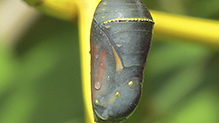 |
|
Luciearl |
||
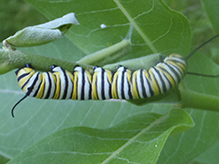 |
||
Monarch caterpillar on milkweed. |
||
Monarch caterpillar on milkweed. |
||
 |
 |
|
Dan W. Andree |
||

A Monarch on Blanket Flowers... Earlier in June I seen this Monarch at Frenchman’s Bluff SNA but since have only seen a pair mating earlier in June and one other one just flying across the prairie. While the prairie has really grown some of the main flower species are just budding out and last time I was out there maybe 5% of the wild bergamot were flowering. There is a lot of bergamot and other species but haven’t blossomed out really. That will change fast though. You can see the blanket flowers were blurred somewhat due to rather breezy too darn right windy at times on that day. The Monarch was a male because when its wings were open it had a dark blackish spot on each lower wing area. Fed for a very short time and flew off in the wind. |
||
 Monarch & Regal... I just put this photo write-up together. I felt since many are familiar with the monarch showing a monarch with a regal fritillary may get more people familiar with that species too. They are a couple of butterflies I seen on one of my outdoor adventures in Norman Co. Mn. I may put together a video in the future with both the monarch and regal fritillary butterflies in the same video. Since regals pretty much remain on prairies they are seen much less than the monarchs which can be found in a variety of areas. But the regal fritillary is quite beautiful particularly early in its life. They do get really tough looking and almost unrecognizable near the end of their life. But they certainly are worthy of preservation just like the monarch. |
||
“Mating Monarchs” I seen several Monarchs at Frenchman’s Bluff SNA on 8-13-22 a few were at the beginning of the hike but the majority of them were on the far side slope of the big hill going down. There were so many flowers blooming and I counted at least a dozen Monarchs just feeding and seen 3 pairs mating. So to me it is a typical year for the Monarch at that site. In fact the Monarch was the most abundant species seen. I only seen 2 Varigated Fritillaries and one small yellow butterfly. No other species other than the abundance of Monarchs which were easy to spot. I think there are other species threatened and endangered that go unnoticed. The Regal Fritillary being one. |
 |
|
 |
 |
|
“Monarch Butterfly” |
“Mating Monarch Butterflies” I do not see that many Monarch butterflies in a lot of areas. I read they were declining. I was glad to come across some at Frenchman’s Bluff - Scientific and Natural Area in rural Norman Co. Mn. |
|
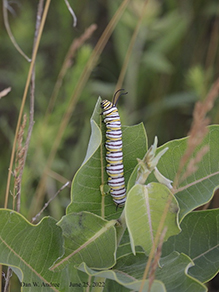 |
 |
|
Monarch Caterpillar... Seen it feeding on milkweed June 25, 2022 out at Frenchman’s Bluff SNA. |
Mating Monarchs... Seen a couple pairs mating this is one pair. Aug. 1, 2022 on a prairie in Norman Co. Mn. |
|
 |
||
Monarch Butterfly - Sandpiper Prairie SNA in Norman Co. Mn. |
||
Kirk Nelson |
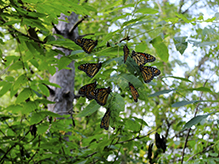 |
Mike Poeppe |
||
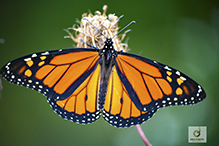 |
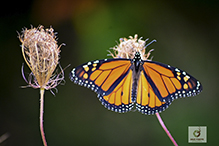 |
|
 |
||
Rick Thome |
||
found these flowers with dozen monarchs feeding on deep in pond grass |
||
 |
 |
|
Alfredo Colon |
||
 |
 |
|
 |
 |
|
 |
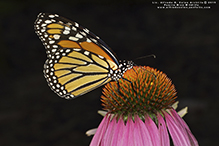 |
|
 |
 |
|
 |
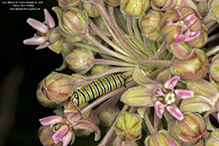 |
|
Lynn Rubey |
||
A Monarch Caterpillar on a Milkweed plant in The Big Stone National Wildlife Refuge. Milkweed plants are essential for the Monarch's survival since the caterpillars eat only Milkweed. |
||
 |
 |
|
 |
||
| A female Monarch on a blade of grass between the Pool 7 and the West Pool in The Big Stone National Wildlife Refuge, there are several Milkweed plants nearby that the Monarch needs for survival. | ||
Gerry Garcia |
 |
SaraBug |
||
Found 3 monarch eggs on the only milkweed plant in my yard! 2 of 3 hatched the next day, and the third one is about to hatch today (7/17/19). |
||
 |
 |
|
Norm & Peg Dibble |
||
 |
||
| Here’s some neat photos that Norm took of a Monarch chrysalis that was on the back garden fence, a surprising distance from our only Swamp Milkweed plant. | ||
Then there was also another one very high up on our shed at the eaves. At least it found some shade there. We were able to photograph many stages of the Monarch as it came out of the chrysalis and worked slowly to open its wings. |
||
 |
 |
|
Margot Avey |
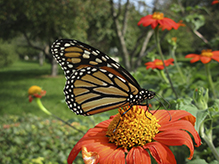 |
Trisha |
||
Monarch Butterfly |
||
 |
 |
|
Robert Briggs |
 |
Monarch butterfly at Spring Lake Park Reserve on October 29th. It seems awfully late in the season to be seeing these. |
Wayne Rasmussen |
||
Monarch on swamp milkweed |
||
 |
 |
|
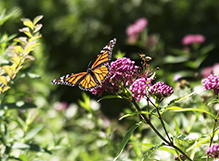 |
 |
|
Joy Park summer wildflowers and insects are available for viewing |
||
| Monarch on swamp milkweed | ||
Monarchs can be found all over Minnesota. The first was found in rural Dodge County and the other in Maplewood on the Bruentrop Historical Site. Our home and Maplewood Hts Park was once part of the Bruentrop farm. |
||
 |
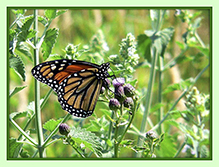 |
|
Bill Reynolds |
||
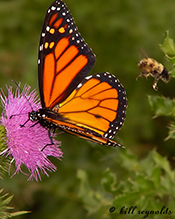 |
 |
|
This is a Monarch caterpillar on Common Milkweed. |
||
There is a pretty good sized Bull Thistle patch near where I live that the bees and butterflies are working pretty hard. |
|
|
Tom Baker |
||
 |
 |
|
 |
 |
|
MinnesotaSeasons.com Photos
 |
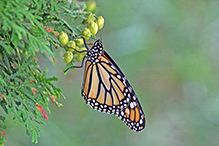 |
|
 |
 |
|
 |
 |
|
 |
 |

Slideshows
Monarch Metamorphosis
Andree Reno Sanborn
Danaus plexippus (Monarch)
Allen Chartier
Monarch Butterfly Emerges
Andy Reago & Chrissy McClarren
Monarch
jt893x

Visitor Videos
Share your video of this insect.
This button not working for you?
Simply email us at info@MinnesotaSeasons.com.
Attach a video, a YouTube link, or a cloud storage link.
Mark Teske
Monarch drying
Jul 29, 2025
Dan W. Andree
"Monarch & Viceroy Butterflies" Filmed by Dan W Andree
Published on Mar 23, 2016
Other Videos
Monarch Butterflies Migration Google Earth Tour
Encyclopedia of Life
Complete Life Cycle of the Monarch Butterfly
dscottprod
Why fewer monarch butterflies are surviving their winter migration to Mexico
PBS NewsHour
Monarch Butterflies
National Geographic

Visitor Sightings
Report a sighting of this insect.
This button not working for you?
Simply email us at info@MinnesotaSeasons.com.
Be sure to include a location.
Mark Teske
7/28/2025
Location: North Branch, MN
Do y'all like pictures like this/these? I don't want to bother you.
Bobbi Johnson
10/13/2024
Location: Silver Bay, MN
The monarch was in the last vestige of the Joe Pye Weed
Kristin Mikelyn Martinson
9/20/2024
Location: Buffalo, MN near Crawford Lake
Many many many Monarch butterflies coming to our late blooming Lilac bush in the front yard the past few days. It is so neat to see them here again.!
Dan W. Andree
6/11/2024

Location: Frenchman’s Bluff SNA
Earlier in June I seen this Monarch at Frenchman’s Bluff SNA but since have only seen a pair mating earlier in June and one other one just flying across the prairie. While the prairie has really grown some of the main flower species are just budding out and last time I was out there maybe 5% of the wild bergamot were flowering. There is a lot of bergamot and other species but haven’t blossomed out really.
That will change fast though. You can see the blanket flowers were blurred somewhat due to rather breezy too darn right windy at times on that day. The Monarch was a male because when its wings were open it had a dark blackish spot on each lower wing area. Fed for a very short time and flew off in the wind.
A/C Christian
Church of
Minneapolis
7/22/2023
Location: Westwood Hills Nature Center
At the Westwood Hills Nature Center, we saw some life on July 22 this year.
This was all found by the A/C Christian Church of Minneapolis.
Dan W. Andree
8/21/2022
Location: Frenchman’s Bluff SNA
At Frenchman’s Bluff SNA. I had no idea what it was. At first from a distance thought it might be a darker colored Variegated Fritillary but got closer to it and seen it was a butterfly I had never seen before. Its colors reminded or made me think of fall harvest decorations. Like fall color leafs and orange and brown etc. colors pumpkin colors etc. Beautiful butterfly. Also for a first time seen some Common Copper Butterflies at Twin Valley Prairie SNA. I filmed and photographed them they were little and really cute. I got some photos of that Tortoiseshell so will see how they turned out I filmed it but not sure if I got it very good. I haven’t uploaded the footage to a larger monitor. I know the Common Copper photos and video is really nice so hope some of the Milbert’s Tortoiseshell is nice to. I do think some photos will be but not so sure about the video.
Seen so many Monarch’s at both SNA’s mentioned here. I swear a couple hundred or more. They were feeding on mostly prairie blazing star flowers. I could carefully walk through areas and monarchs flew up 3-6 feet in front of me. Some just sat and fed if I was motionless. Not a very spooky butterfly. A few were still mating but most feeding. Must have been a hatch out or something. Didn’t see any regals and haven’t seen any at all at Frenchman’s this whole season but did see a few males at the other mentioned SNA which was nice to see.
Monarchs seem to be doing extremely well in the two mention SNA’s which is good but some other lesser known species not so much. Monarchs were the only species of large butterflies seen. Only seen 2 painted ladies which sometimes they can be all over the place but not a whole lot of species observed this season other than the Monarchs and happy to say lots of them. Concerning though for the other species.
… Seen the Tortoiseshell and Common Coppers yesterday mid afternoon to late afternoon.
Dan W. Andree
8/13/2022

Location: Frenchman’s Bluff SNA
I seen several Monarchs at Frenchman’s Bluff SNA on 8-13-22 a few were at the beginning of the hike but the majority of them were on the far side slope of the big hill going down. There were so many flowers blooming and I counted at least a dozen Monarchs just feeding and seen 3 pairs mating. So to me it is a typical year for the Monarch at that site. In fact the Monarch was the most abundant species seen. I only seen 2 Varigated Fritillaries and one small yellow butterfly. No other species other than the abundance of Monarchs which were easy to spot. I think there are other species threatened and endangered that go unnoticed. The Regal Fritillary being one.
Dan W. Andree
8/1/2022
Location: Norman Co. Mn.
Seen a couple pairs mating this is one pair. Aug. 1, 2022 on a prairie in Norman Co. Mn.
Dan W. Andree
6/25/2022
Location: Frenchman’s Bluff SNA
Seen it feeding on milkweed June 25, 2022 out at Frenchman’s Bluff SNA.
Kirk Nelson
8/28/2021
Location: Whitetail Woods Regional Park
Walking through the pine woods in the southern part of the park, I came across an abundance of monarchs flitting about and resting in the bushes.
Mary Ann
8/28/2019
Location: Loring Park
August 26, 27 and 28—congregations of 5-7 Monarchs floating on a strong breeze and basking in sun on lower branches of Elm trees in Loring Park.
Dan W. Andree
8/10/2019
Location: Frenchman’s Bluff Scientific and Natural Area in rural Norman Co. Mn
I do not see that many Monarch butterflies in a lot of areas. I read they were declining. I was glad to come across some at Frenchman’s Bluff - Scientific and Natural Area in rural Norman Co. Mn.
Lynn Rubey
8/9/2019
Location: Big Stone National Wildlife Refuge
A Monarch Caterpillar on a Milkweed plant in The Big Stone National Wildlife Refuge. Milkweed plants are essential for the Monarch's survival since the caterpillars eat only Milkweed.
Lynn Rubey
8/4/2019
Location: Big Stone National Wildlife Refuge
A female Monarch on a blade of grass between the Pool 7 and the West Pool in The Big Stone National Wildlife Refuge, there are several Milkweed plants nearby that the Monarch needs for survival.
SaraBug
7/15/2019
Location: Minneapolis
Found 3 monarch eggs on the only milkweed plant in my yard! 2 of 3 hatched the next day, and the third one is about to hatch today (7/17/19).
Norm & Peg Dibble
7/15/2019
Location: Maple Grove, MN
Then there was also another one very high up on our shed at the eaves. At least it found some shade there. We were able to photograph many stages of the Monarch as it came out of the chrysalis and worked slowly to open its wings.
Marilyn Carlson
8/30/2017
Location: Annandale, MN
When can I safely pull out the milkweed plants that are growing in my flower garden? I would really like to get milkweed growing along side our driveway ditch so it can grow basically wild with no problem of being cut or pulled out or sprayed. As it is really starting to take over my flower garden. If I take the milkweed pods/seeds and sprinkle them in this area what are the chances of the growing next spring? We are seeing some Monarchs at this time (8-30-2017)
Robert Briggs
10/29/2016
Location: Spring Lake Park Reserve
It seems awfully late in the season to be seeing these.
Wayne Rasmussen
7/20/2016
Location: Joy Park
Joy Park summer wildflowers and insects are available for viewing
Wayne Rasmussen
8/10/2014
Location: Dodge County
Monarchs can be found all over Minnesota. The first was found in rural Dodge County and the other in Maplewood on the Bruentrop Historical Site. Our home and Maplewood Hts Park was once part of the Bruentrop farm.
Bill Reynolds
9/5/2015
Location: Pennington Co.
There is a pretty good sized Bull Thistle patch near where I live that the bees and butterflies are working pretty hard.
Crystal Boyd
6/10 and 6/11/2013
Location: Uncas Dunes SNA
MinnesotaSeasons.com Sightings
Avon Hills Forest SNA, North Unit
Badoura Jack Pine Woodland SNA
Bertram Chain of Lakes Regional Park
Blazing Star Prairie Addition Preserve, South Unit
Carpenter St. Croix Valley Nature Center
Carver Highlands WMA, South Unit
Charles A. Lindbergh State Park
Clifton E. French Regional Park
Felton Prairie SNA, Bicentennial Unit
Felton Prairie SNA, Shrike Unit
John Peter Hoffman Spring Brook Valley WMA
Kellogg Weaver Dunes SNA, Kellogg Weaver Unit
Margherita Preserve-Audubon Prairie
Minnesota Valley NWR, Louisville Swamp Unit
Minnesota Valley NWR, Rapids Lake Unit
Minnesota Valley NWR, Wilkie Unit
Mound Spring Prairie SNA, North Unit
Northern Tallgrass Prairie NWR, Hoffman Unit
Northern Tallgrass Prairie NWR, Pavia Unit
Northern Tallgrass Prairie NWR, Rengstorf Unit
Northern Tallgrass Prairie NWR, Spieker Unit
Northern Tallgrass Prairie NWR, Touch the Sky Prairie Unit
Pankratz Memorial Prairie, North Unit
Pembina Trail Preserve SNA, Crookston Prairie Unit
Pembina Trail Preserve SNA, Pembina Trail Unit
Prairie Creek WMA, Koester Prairie Unit
Richard M. & Mathilde Rice Elliott SNA
Sand Prairie Wildlife Management and Environmental Education Area
Two Rivers Aspen Prairie Parkland SNA
Verlyn Marth Memorial Prairie SNA











